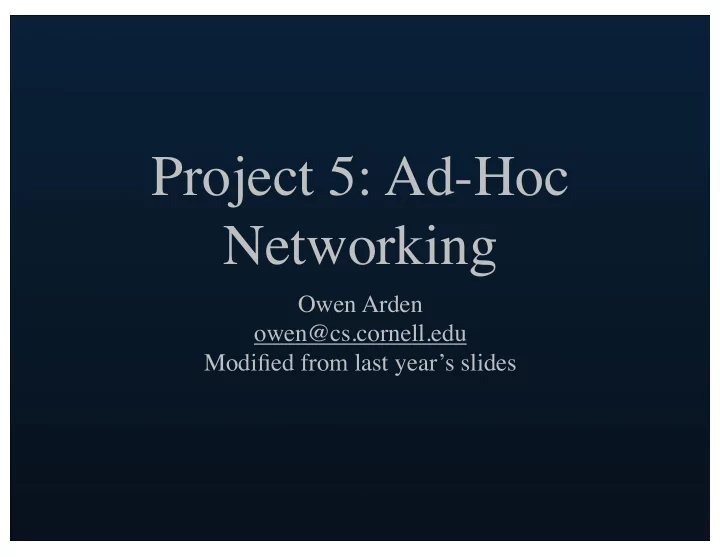

Project 5: Ad-Hoc Networking Owen Arden owen@cs.cornell.edu Modified from last year’s slides
Miniroute • Ad-hoc networking layer • Allows multi-hop wireless communication without the need for infrastructure • Low-cost • Quick deployment time • No single point of failure • Based on Dynamic Source Routing (DSR) • http://www.cs.cornell.edu/People/egs/615/johnson-dsr.pdf
What is routing? • Packets that arrive at your machine may User Application not be for you TCP-like protocol • Add a routing layer between network and UDP-like protocol transport layer Routing • minimsg/sockets works on top Network
Dynamic Source Routing • To deliver a packet when the route is unknown, broadcast a route discovery packet • In-range hosts re-broadcast discovery packet, attaching themselves as part of the route • When destination is reached, a reply is sent along the reversed path.
Dynamic Source Routing • If the source receives a reply, add to the route cache , and use route to send data. • For simplicity, route cache entries expire in 3 seconds to prevent stale routes • Real protocols have error handling that allows routes to be re-discovered only when necessary
Unreachable hosts • How does the protocol terminate if a host is unreachable? • A TTL (time to live) field initialized to MAX_ROUTE_LENGTH is decremented on each re- broadcast • If TTL is 0 and host is not the destination, do not rebroadcast • A host should not re-broadcast a discovery request it has broadcasted before • Route discovery IDs are assigned per packet to prevent redundant re-broadcasts.
Implementation • Replace network_send_pkt with miniroute_send_pkt • Update network handler • Recognize miniroute header • Routing control packets must be passed to routing thread • Data packets delivered to ports/socket if arrived at destination, otherwise routed to next-hop
Implementation • Routing thread • State machine for handling and routing packets • Use network_bcast_pkt for broadcasts • Route cache • SIZE_OF_ROUTE_CACHE entries • Invalidate after timeout (with or without alarms) • Aim for average access time of O(1) or O(logN) • Table for node discovery packet IDs • Can assume some max lifetime of an ID
Instant Ad-Hoc Messaging • Write an IM application using miniroute • Requires reading input from user • Add read.c, read.h, read_private.h • Include “read_private.h” in minithread.c • Add miniterm_initialize() • Use miniterm_read() to read data from the keyboard
Additional Changes • In network.h • Set BCAST_ENABLED to 1 • Set BCAST_ADDRESS • X.Y.Z.255 for most networks, where X,Y,Z are the first three octets of your IP • Try setting up an ad-hoc network between laptops • Set BCAST_TOPOLOGY_FILE • see project description for format
Additional Requirements • At any host, there must be at most a single routing discover request for any destination at any one time: • Multiple threads should not trigger multiple requests for the same destination • Only one cache entry per destination • Use reply packets with the latest information • Use structures and data-types provided in miniroute.h • Routing should work across groups, but other protocols don’t have to
Additional Requirements • Routing interoperability requires routing header entries to be in network order • Every short, int, long, must be translated to network order before being send, and translated to host order after being received. • See functions in network.c
For the ambitious • Routing cache does not need to have a timeout. • Hosts detect broken links, send back errors. • Source host can purge cache entry and discover new route • Requires integrity of each hop to be verified • Hop-to-hop ACKs : very very inefficient • Eavesdropping : each host waits for next hop to forward. • Replace unicast hop to hop sends with broadcasts • Additional filtering in network handler
Localized Route Patching • Hop that discovered the broken route perform a new route discovery • Patch route and continue routing packet • Route cache on both source/destination should eventually be updated
Aggressive Caching • Every reply/request/data packet routed is an opportunity • BUT- only some of the data is worth caching, and is different depending on whether it is a reply/request/data pkt
Redundant Routes • By keeping additional routes, packets can be quickly re-routed if a route breaks • Can be re-routed on error at source, or embedded in header to allow localized re-routing
Hybrid Proactive/Reactive Routing • See Prof. Sirer’s SHARP http://www.cs.cornell.edu/courses/cs414/2004SP/papers/sharp.pdf
Recommend
More recommend